BUSINESS MODEL ARCHETYPES
转:http://nealcabage.com/framework/business-model-archetypes/
“The 7 Fundamental Business Model Personalities”
The Business Model Archetypes are seven fundamental business “personalities” upon which any business model can be developed. By providing the context of all available models, it becomes easier to see how businesses relate and directions in which businesses can pivot. In this article, I describe the model and the archetypes, that I first introduced in my book The Smarter Startup, as well as describe use patterns where the models might benefit entrepreneurs and product strategists who use the model.
BACKGROUND & CONTEXT
The purpose of a business model is to concisely describe the function of your business within the overall market landscape, including details such as business inputs and dependencies, target customer base, and the value being created on behalf of those customers. By using such a conceptual construct for evaluating a business, strategists are able to more easily understand the function of the business, identify strengths, weaknesses, and opportunities, by comparing the attributes of other similar businesses who may be using a similar structural model.
While the concept is great, the value of such an exercise is lost on many product managers, who require something a bit more compact and immediately usable. There is a growing library of popular models that go by names like ‘Razor and Blades’ and ‘Network Effects Business’ which describe popular models that have been successfully used by other companies, but the knowledge is diffuse and there is little organization or context from which to easily discover and compare model options that may be appropriate for a business. The net result is that unless you have formally studied business strategy, there’s a good chance you are not aware of these known models, and thus the wisdom they represent is not leveraged. It is critical however for product managers to clearly articulate the function and contact of their business in the market.

It was with this challenge in mind that a different approach was developed, called The Business Model Archetypes. The concept is derived from work by Carl Jung, the 20th-century Psychiatrist who suggested there are fundamental personality templates from which we all inherit and combine attributes to create our own personalities. By understanding the fundamental templates he believed, you could better understand the personality of an individual, and predict their response to a variety of stimulus. He called this theory, the Personality Archetypes.
Jung’s concept is also relevant to the fundamental personalities of a business and provides an excellent structural base from which to identify the spectrum of possible templates. In the case of businesses, there are three primary personalities that describe the fundamental interests and activities of every business. And, similar to an additive color wheel, three secondary archetypes are derived by combing attributes of the three primary archetypes: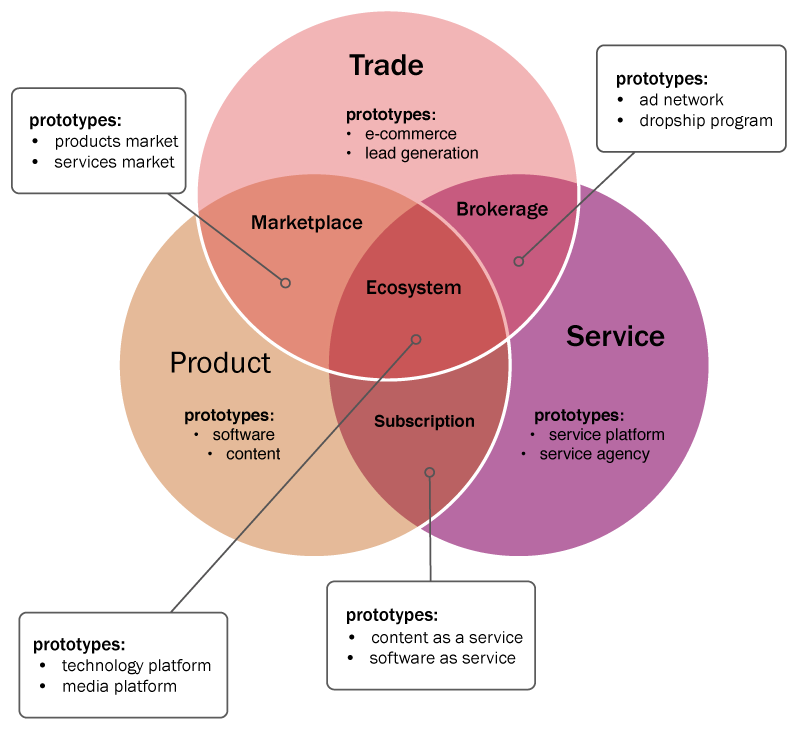
PRIMARY
- Product – one time purchase of an artifact
- Service – manually doing something and charging a fee
- Trade – Connecting buyers and sellers for commerce
SECONDARY
- Brokerage – providing trade as a service
- Subscription – productizing and semi-automating a service
- Marketplace – productizing trade with a self-service platform
- Ecosystem – Platform that combines all three (Mature)
ABOUT THE MODEL
These seven archetypes are high-level abstractions that describe basic truths about categories of businesses. This can be helpful for identifying a generalized context from which to determine where in the spectrum of possibilities to focus your efforts, but it is not specific enough to be actionable. For this, two prototypes were added to each of the model archetypes. A prototype is a more specific and functional demonstration of what is possible within a model archetype.
To demonstrate this idea, the Trade archetype has two prototype examples: eCommerce and Lead Generation. Both are examples of sourcing something of value and bringing it to the market for sale. In both cases, money is made on the spread between the cost of acquiring the item and what it can be sold for by the trader by taking it to market and promoting it. Similarly software and content are the two most common types of products to sell if you are an online business.
Being able to see the spectrum of structural options is a great place to begin thinking through the strategy of your business. Typically, teams will find they relate more strongly to one of the archetypes than the others, but while evaluating their options more closely, they might be able to reasonably pivot to the neighboring archetypes, providing additional opportunity and potentially even a more innovative and effective approach to their business. A well-connected Trader for example might find interest in expanding their business through a Brokerage model, by providing Dropship fulfillment of their products. Or they may be interested in building a category-leading brand online by establishing the go-to Marketplace for the types of products they specialize in.
The important point is to take the time to do the analysis and to understand the primary function of your business and to consider the possible variations on your theme that might be more optimal that what you’re currently doing. That is where the Business Model Archetypes framework is useful, by providing a conceptual framework with which to think through the possible opportunities you may not have considered. At the end of the day, every product manager be able to clearly articulate their business’s foundational strategy and to understand their context and expansion and pivot options – this framework provides a simplified method for achieving these goals.
ABOUT THE ARCHETYPES
Here’s a brief description of each of the archetypes to demonstrate further:
I. PRODUCT
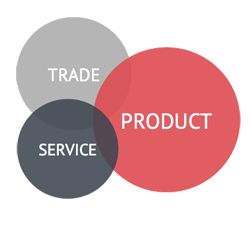
This primary archetype focuses on the development of a tangible artifact that can be bought and sold for a one-time cost. The product is usually consumed either because it provides personal entertainment, or because it offers some gain of efficiency and can be acquired for less cost than hiring a services company to perform an activity. When applied to the online world, the most common types of products are software in the form of plugins for major platforms such as WordPress, or content in the form of mobile apps of ebooks.
Indicative Attributes
- Key partners: Marketplaces
- Value proposition: Productivity or entertainment
- Key Activities: Product Development
- Monetization: Sale of product
II. SUBSCRIPTION

This secondary archetype is a popular blend of a product and a service. The most common examples are software as a service (SaaS) and Content as a Service (CaaS). Rather than buying a tangible product one time at a maximum cost, the subscription model provides continued access to the product or service for a lesser monthly cost, and continues to update, improve, and support the product over its lifetime. The benefit for the business is a reduction in up-front cost, reduced dependency upon a marketplace, and a continued relationship with the customer. For the customer, its also a way to reduce up-front cost, and ofte means having access to more and better resources than if they needed to purchase the tangible equivalent.
Indicative Attributes
- Key partners: Ecosystem platform owner
- Value proposition: Customization and support of platform
- Key Activities: Customization and maintenance
- Monetization: Time and materials
III. SERVICE
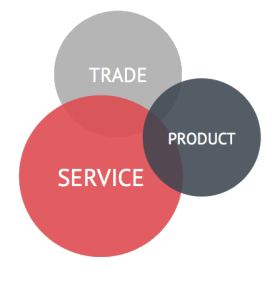
The third primary archetype provides intangible solutions for customers and clients, where commoditized products are not sufficient. Often this is in the form of integration, maintenance, or customization of a popular platform solution. Usually this type of organization is formed by an organization of skilled professionals who sell their services for an hourly rate.
Indicative Attributes
- Key partners: Ecosystem platform owner
- Value proposition: Customization and support of platform
- Key Activities: Customization and maintenance
- Monetization: Time and materials
IV. BROKERAGE
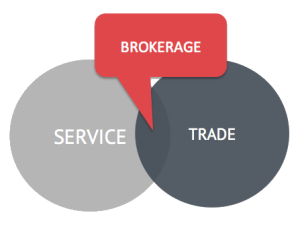
This a secondary archetype which combines the activities of Trade and Service by trading on behalf of clients, as a service. These businesses typically service consumer-facing brands that focus on marketing and need assistance with more efficient sourcing. Prototype examples of this type of business include advertising networks which provide online traffic sourcing for brand retailers, and dropship programs which often have deeper sourcing relationships, and better fulfillment relationships than the brands they service.
Indicative Attributes
- Key partners: Wholesalers
- Value proposition: Efficient commodity procurement
- Key Activities: Recruiting Wholesalers
- Monetization: Base fee plus commission
V. TRADE
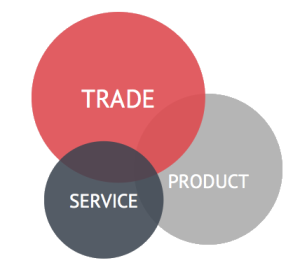
The primary archetype of Trade focuses on connecting buyers and sellers. Money is earned by buying a product for less than it IS sold for. The trader’s primary occupation is sourcing something of value “in the field”, packaging it, and making it readily available to those who desire it. Prototypical examples include the eCommerce retailer and lead generation. In both of these examples, the Trader sources something, qualifies and prepares it, then sells it to a customer. In the case of lead generation the behavior is the same as retail, except that the product is information about a customer prospect.
Indicative Attributes
- Key partners: Product sourcing and advertising
- Value proposition: Low price, convenience, and curation
- Key Activities: Sourcing and advertising
- Monetization: Product arbitrage
VI. MARKETPLACE
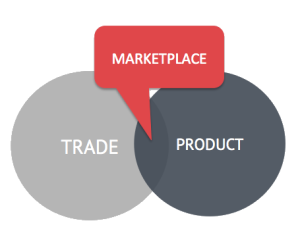
The Marketplace is a secondary archetype that combines attributes of of the primary Trade and Product archetypes. It brings together buyers and sellers for trade, but it does o via self-service platform which itself is product. The product could be a physical shopping mall or an online technology platform that facilitates payment processing and statistical reporting. What is sold in a marketplace can either be tangible products or services. In both cases, the value and the efficacy of the marketplace is affected by Metcalfe’s law (aka Network Effects): the value of the network exponentially increases with every new node on the network. This can be a powerful dynamic that sustains a marketplace once critical mass is achieved, though it can also be rather difficult to reach critical mass to begin with.
Indicative Attributes
- Key partners: Merchants (sellers)
- Value proposition: Destination shopping
- Key Activities: Recruit vendors and advertise
- Monetization: Commission per sale
VII. ECOSYSTEM

The Ecosystem is the only Tertiary archetype in this model, in that it combines all three primary archetypes – Product, Service, and Trade. This is the rarest and most difficult archetype to achieve but is the more desirable. Success with one primary or secondary archetype behavior typically opens up the opportunity to extend the brand into complimentary and synergistic offerings. A product creator for example, may start to offer services in support of their product. If that too is successful, they may begin looking at how to facilitate marketplace activities and a host of other supportive behaviors. All of the synergistic activity helps to entrench the brand as a market leader, and adds to the value chain and perceived value of the customer. Typical prototype examples of an ecosystem are the technology platform (Salesforce CRM, Microsoft, etc) and the media platform (NBC, Facebook, etc).
Indicative Attributes
- Key partners: PaaS providers
- Value proposition: Turnkey software and management
- Key Activities: Develop software and manage servers
- Monetization: Subscription fee